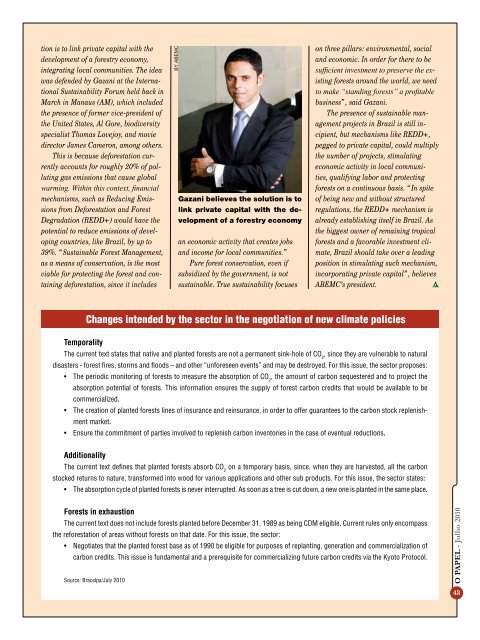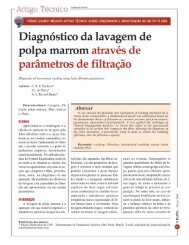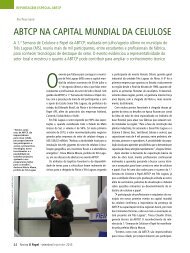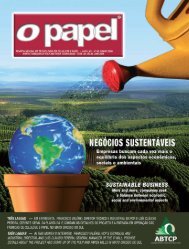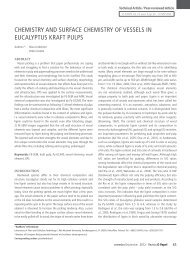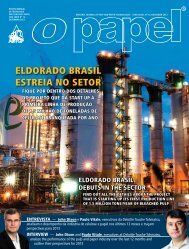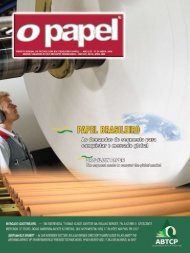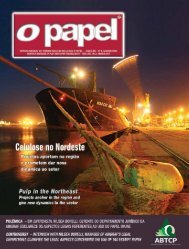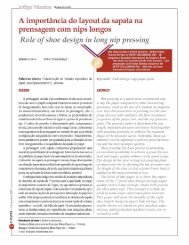mercado de créditos de carbono - Revista O Papel
mercado de créditos de carbono - Revista O Papel
mercado de créditos de carbono - Revista O Papel
Create successful ePaper yourself
Turn your PDF publications into a flip-book with our unique Google optimized e-Paper software.
tion is to link private capital with the<br />
<strong>de</strong>velopment of a forestry economy,<br />
integrating local communities. The i<strong>de</strong>a<br />
was <strong>de</strong>fen<strong>de</strong>d by Gazani at the International<br />
Sustainability Forum held back in<br />
March in Manaus (AM), which inclu<strong>de</strong>d<br />
the presence of former vice-presi<strong>de</strong>nt of<br />
the United States, Al Gore, biodiversity<br />
specialist Thomas Lovejoy, and movie<br />
director James Cameron, among others.<br />
This is because <strong>de</strong>forestation currently<br />
accounts for roughly 20% of polluting<br />
gas emissions that cause global<br />
warming. Within this context, financial<br />
mechanisms, such as Reducing Emissions<br />
from Deforestation and Forest<br />
Degradation (REDD+) would have the<br />
potential to reduce emissions of <strong>de</strong>veloping<br />
countries, like Brazil, by up to<br />
39%. “Sustainable Forest Management,<br />
as a means of conservation, is the most<br />
viable for protecting the forest and containing<br />
<strong>de</strong>forestation, since it inclu<strong>de</strong>s<br />
BY ABEMC<br />
Gazani believes the solution is to<br />
link private capital with the <strong>de</strong>velopment<br />
of a forestry economy<br />
an economic activity that creates jobs<br />
and income for local communities.”<br />
Pure forest conservation, even if<br />
subsidized by the government, is not<br />
sustainable. True sustainability focuses<br />
on three pillars: environmental, social<br />
and economic. In or<strong>de</strong>r for there to be<br />
sufficient investment to preserve the existing<br />
forests around the world, we need<br />
to make “standing forests” a profitable<br />
business”, said Gazani.<br />
The presence of sustainable management<br />
projects in Brazil is still incipient,<br />
but mechanisms like REDD+,<br />
pegged to private capital, could multiply<br />
the number of projects, stimulating<br />
economic activity in local communities,<br />
qualifying labor and protecting<br />
forests on a continuous basis. “In spite<br />
of being new and without structured<br />
regulations, the REDD+ mechanism is<br />
already establishing itself in Brazil. As<br />
the biggest owner of remaining tropical<br />
forests and a favorable investment climate,<br />
Brazil should take over a leading<br />
position in stimulating such mechanism,<br />
incorporating private capital”, believes<br />
ABEMC’s presi<strong>de</strong>nt.<br />
Changes inten<strong>de</strong>d by the sector in the negotiation of new climate policies<br />
Temporality<br />
The current text states that native and planted forests are not a permanent sink-hole of CO 2<br />
, since they are vulnerable to natural<br />
disasters - forest fires, storms and floods – and other “unforeseen events” and may be <strong>de</strong>stroyed. For this issue, the sector proposes:<br />
• The periodic monitoring of forests to measure the absorption of CO 2<br />
, the amount of carbon sequestered and to project the<br />
absorption potential of forests. This information ensures the supply of forest carbon credits that would be available to be<br />
commercialized.<br />
• The creation of planted forests lines of insurance and reinsurance, in or<strong>de</strong>r to offer guarantees to the carbon stock replenishment<br />
market.<br />
• Ensure the commitment of parties involved to replenish carbon inventories in the case of eventual reductions.<br />
Additionality<br />
The current text <strong>de</strong>fines that planted forests absorb CO 2<br />
on a temporary basis, since, when they are harvested, all the carbon<br />
stocked returns to nature, transformed into wood for various applications and other sub products. For this issue, the sector states:<br />
• The absorption cycle of planted forests is never interrupted. As soon as a tree is cut down, a new one is planted in the same place.<br />
Forests in exhaustion<br />
The current text does not inclu<strong>de</strong> forests planted before December 31, 1989 as being CDM eligible. Current rules only encompass<br />
the reforestation of areas without forests on that date. For this issue, the sector:<br />
• Negotiates that the planted forest base as of 1990 be eligible for purposes of replanting, generation and commercialization of<br />
carbon credits. This issue is fundamental and a prerequisite for commercializing future carbon credits via the Kyoto Protocol.<br />
Source: Bracelpa/July 2010<br />
O PAPEL - Julho 2010<br />
43


